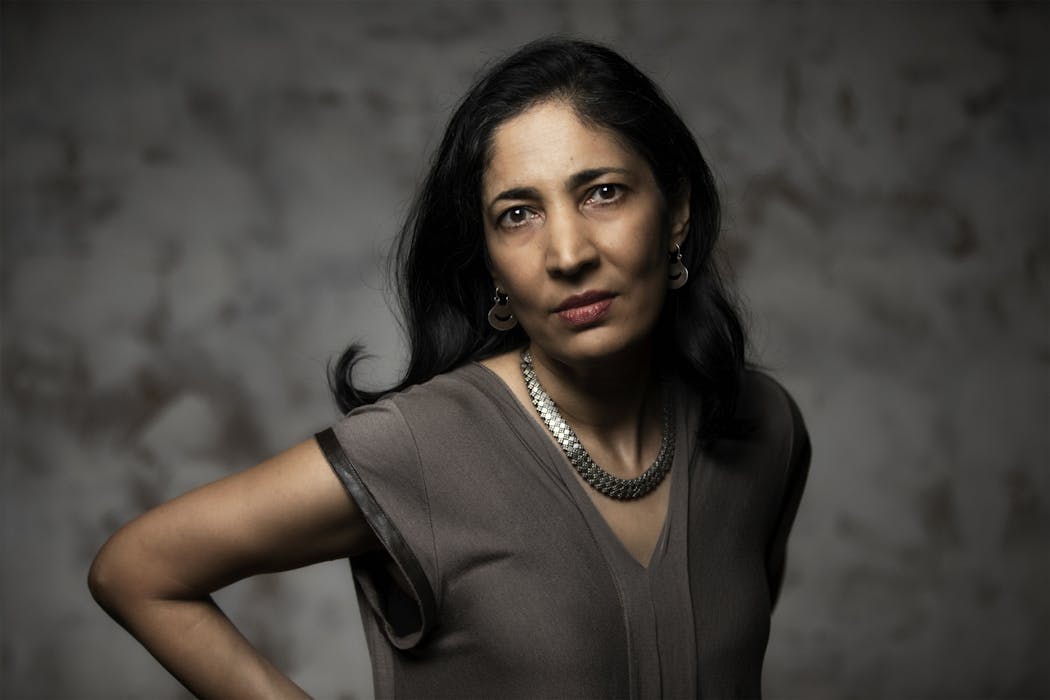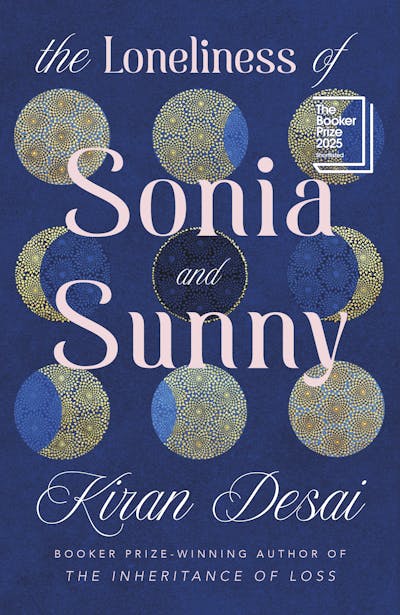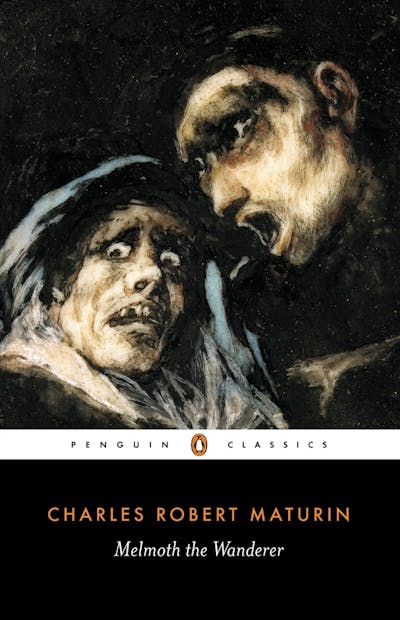
Kiran Desai’s surname was familiar to the world of literature when her second novel, The Inheritance of Loss, won the Man Booker Prize in 2006. Her mother, Anita Desai, was already an accomplished novelist, who had been nominated for the Booker three times. The Inheritance of Loss was hailed as a defining example of both the postcolonial novel and the realist novel of the Indian diaspora: Indians living elsewhere, around the world.
The wait for her next novel – currently shortlisted for the 2025 Booker Prize – has been nearly 20 years. The Loneliness of Sonia and Sunny is a globetrotting love story between two Indian-Americans, Sonia and Sunny. Sonia’s darkly disturbing relationship with Ilan, a modernist artist with devilish predatory powers, sets the context for the rest of the novel. Ilan’s narcissistic and oedipal leanings shadow Sonia and Sunny’s own search for love.
It’s a huge novel: epic in scope, complex in ideas and rich with interconnecting themes, generically fluid – and a very good read.
Review: The Loneliness of Sonia and Sunny – by Kiran Desai (Hamish Hamilton)
Desai’s debut had many of these characteristics, too. It explored the sense of non-belonging in the Indian diaspora and the loss of liberal values in India itself, a homeland cursed by the spectre of casteism.
But despite its Booker win (and some critical acclaim), many readers felt its multiple narratives – revolutionaries in a Himalayan town, unethical capitalist practices among Indians in the United States, a general disdain towards Indians generally – displaced the central touching love tale, between Sai, a privileged Indian girl, and her tutor Gyan, a Nepali sympathetic to the Nepali insurgents (the Gorkha National Liberation Front).
The Loneliness of Sonia and Sunny has multiple narrative strands, but they don’t overtake its central story, nor its central question. That is, how to fictionalise the task of representing two nations, which its characters both do and don’t belong to. (A central dilemma of both Indians and the Indian novel in the diaspora.)
For Desai, these nations are India, where she spent much of her childhood, and the US, where she moved with her mother as a teenager (after an initial year in the United Kingdom, where her mother had a Cambridge fellowship).
Not an unhappy family saga
The Loneliness of Sonia and Sunny begins in America with two desi (literally “foreign-but-local”) characters. Sonia is a student at Hewitt, a minor college in Vermont, with a nebulous future as a creative writer (her writing is pedestrian and about Indian experiences). Sunny is a New York journalist with an equally uncertain future. Both are seeking a green card, to give them US residency.

They belong to westernised Indian families with members “brought up in British-style boarding schools”. They use many Hindi words in their everyday conversation – bindi, ganga, jootis, chokra – but it is not their “natural” language. (For example: “The evening sun was red as a bindi”.)
The two families, the Shahs and Bhatias, though diametrically opposed in just about everything, are connected through food – especially Indo-Muslim delicacies like kebabs, kakori (kachori) and galawati, which have been thoroughly Indianised. Indeed, food brings the worlds of Sonia and Sunny together. In a letter to her son Sunny, Babita suggests food as “the target of an intrigue”.
Sonia and Sunny’s grandparents suggest their grandchildren may be a perfect match: a suitable boy, after all, holds the key to Indian marriage happiness. They do this through the exchange of Indian delicacies. (A conspiracy by Sunny’s mother to steal Sonia’s Khansama, the cook, is a humorous subplot.)
On finally discovering their families’ plan, Sonia and Sunny reject the idea of an arranged marriage. Sunny has his own relationship with an American girl, Ulla, who thinks arranged marriages are “crazy”. (By contrast, Sunny’s doctor friend Satya, also a desi, opts for an arranged marriage, after the usual Indian practice of successive “bride viewing”.)
Though these references are incidental, they are also a great strength of the novel: the lives of family members enter into the Sonia–Sunny master narrative and often displace it. It is to Desai’s credit that, like 19th-century French novelist Honoré de Balzac, she makes her minor characters significant characters in the novel – notably, Sunny’s mother Babita (a widow) and Sonia’s mother and father (separated).
The great Indian novel
The great Indian novelists in the diaspora have no localised centre, Desai suggests. Their imagined worlds vacillate between locations: India and the UK, US or elsewhere. None of these places afford a solid grounding, socially or ethically.
These writers are faced – urgently, even self-consciously – with the question of what form the Indian novel written from elsewhere around the world should take. How do they create a genre that grows from the ironic potential (and vast tradition) of the European bourgeois-realist novel – but also parts company from it to reflect Indian experiences and culture?

The creative trick, it seems, is to fold an interrogation of the novel as a literary form into its composition. The omniscient narrator of The Loneliness of Sonia and Sunny explicitly discusses a wealth of authors from around the world, including Balzac, Leo Tolstoy, Virginia Woolf, Italo Calvino, Salman Rushdie and Gabriel Garcia Marquez.
The novel also directly references magic realism. Sonia reflects that the term “had been seized upon by the Western world and used to circumscribe the non-Western world”. Later, recalling Ilan’s words, she notes to herself: “Don’t write magic realism nonsense”.
The Loneliness of Sonia and Sunny, like Salman Rushdie’s The Satanic Verses before it, specifically interrogates the Indian novel in the diaspora. In this specific genre, realist prose must engage with the world of magic and mystery: those features of the mystical imagination that define the Indian.
Desai gets around the trope of the Indian diaspora novel as family saga, built on the larger themes of unhappy families, migration, belonging and the nation state in crisis. She also avoids the trope of unhappy diasporas that “criticize America all the time”. How does she do it?
Dark Gothic romanticism

Desai turns not to magic realism (as Rushdie did in Midnight’s Children), but to the dark Gothic romanticism of great American precursors like Herman Melville’s Pierre, or, The Ambiguities (1852) and Nathaniel Hawthorne’s The Marble Faun (1860). She also draws on their earlier Gothic prototype, Charles Maturin’s extraordinary Gothic novel, Melmoth the Wanderer (1820).
Desai writes within this tradition, but acknowledges, as her narrator explicitly says, one cannot properly exist without love: the one orderly principle that makes our fantastical lives liveable.
Sonia and Sunny’s separate lives are uneventful until Sonia meets devilish, predatory modernist artist, Ilan, 32 years older than her – and falls prey to his mysterious allure.
He declares that he paints “seemingly good things as evil and seemingly evil things as good”. But Sonia misses the threat implicit in the declaration – though one dawn hour, she surreptitiously peeps into his painting studio to see another eye, “dilated by urgency” looking at her. Powerless in his presence, she is used as a sex slave, “harried and humiliated”.
Sonia has her own practical needs: the college is closed for winter, and to stay on she needs a job. For the moment, there is no escape from Ilan, whose defining painting, Mother Swimming, functions as a recurring oedipal – and narcissist – motif in the novel.
He demands total “obedience”. Invariably, she gives it – until a dramatic turning point, where she leaves behind her protective totem, a Tibetan amulet: the talismanic demon Badal Baba, “carved with clouds and dragons”.
Return of the repressed
The novel oscillates between two narratives. One is a generational family saga of broken marriages, possessive mothers (Sunny’s father was never loved by his mother) and people with underdeveloped egos. The other is a tale of the return of the repressed, via the disturbing Freudian encounter with the “uncanny”.
The first narrative works on the realist principle laid down by the great theorist of the novel, Georg Lukács. In a groundbreaking essay written in 1914–15, Lukács said that the outward form of the novel is “essentially biographical”, even if its “conceptual system” could never fully capture lived experience. (“Organic unity” and completeness belong only to the “biographical form”.)
The second narrative explores frightening Gothic or neo-Gothic images through the uncanny Ilan, who represents Sonia’s unconscious. His ghostly allure and power confronts her wherever she goes: in Vermont, in Venice’s Fortuny Museum, in Goa where a “huge, white, hairless hound with a harlequin face” will haunt her, even as she finally meets Sunny.
That power is linked to Sonia’s loss of her totemic Badal Baba amulet. Sunny sees Sonia’s constant reference to it as a sign of madness. Its return – which will involve a mysterious doppelganger – now holds the key to the novel’s resolution of its central enigma.
The uncanny finds its most explosive moment in Venice, at an exhibition of Ilan’s paintings in Fortuny Museum, where Sonia panics, almost suffocating at the thought of being followed by the mother in Ilan’s defining oedipal painting, Mother Swimming.
If Venice was marked by one kind of encounter with Ilan, Mexico provides the space for another kind. Here, Sunny is the participant in the surrealist encounter. He gets an assignment in Mexico, after his essay on “Reading Hemingway in Allahabad, Reading Hemingway in Jackson Heights” is accepted in an issue of prestigious literary journal, Granta.
In a Mexican village on the Pacific coast, he discovers Ilan was among a handful of noted artists who had worked there and decides to see his studio – ruins with a chapel and belfry – for himself. Ilan’s art includes a canvas in which a woman’s eye is projected onto a many-panelled mirror: the reflections a kind of mise-en-abyme, or image within an image. Sunny wonders if Ilan is telling Sonia’s story and bluffs his way into his studio. There, strange events unfold.
Navigating reality through fantasy
The disturbing prose of dark romanticism that defines this novel finds its exemplary form in a piece composed by struggling writer Sonia. “A Fable about a woman who becomes a black cloud” is a kind of text within the larger text.
With the Badal Baba amulet now in her possession, she understands the real world itself is multiple, multifarious, decentred – and all one can do is plunge into it, without regard to shape or form. The fantastical feels “right” to Sonia: only through fantasy, she believes, do people overcome their reality.
To Desai, mysticism – the experience of one’s inner world – has its frightening parallel in the darker side of our being. The dark romanticism of the American Gothic provides her with the pathway to this literary form.
Drawing on this genre, she insinuates the Indian novel cannot be limited to realist representation alone. It must enter the disturbing world of the darker side of our being, immortalised in Melmoth the Wanderer and in the dark romanticism of Melville and Hawthorne. Desai gives that experience literary form.
For Desai, this blend of the American Gothic and literary realism seems to hold the key to the American–Indian novel – and the Indian novel of the wider diaspora.
This article is republished from The Conversation, a nonprofit, independent news organization bringing you facts and trustworthy analysis to help you make sense of our complex world. It was written by: Vijay Mishra, Murdoch University
Read more:
- Sofie Laguna explores classic literature and queer desire in The Underworld
- Ethiopian quarter: how migrants have shaped a thriving shopping district in South Africa’s city of gold
- John Grisham’s The Widow: a legal mystery that asks if a sleazy lawyer can ever be seen as a ‘good’ victim
Vijay Mishra does not work for, consult, own shares in or receive funding from any company or organisation that would benefit from this article, and has disclosed no relevant affiliations beyond their academic appointment.


 The Conversation
The Conversation
 Oh No They Didn't
Oh No They Didn't Longmont Times-Call
Longmont Times-Call The Daily Beast
The Daily Beast RadarOnline
RadarOnline Orlando Sentinel Sports
Orlando Sentinel Sports